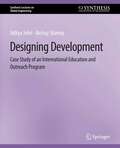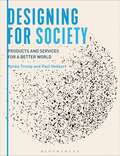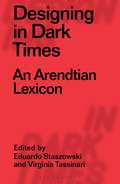- Table View
- List View
Designing Designing (Radical Thinkers in Design)
by John Chris Jonesdesigning designing is one of the most extraordinary books on design ever written. First published in 1984 and reprinted with this title and cover in 1991, the book was the product of ten years of auto-critique, reflection and experimentation on writing on designing. Offering a savage auto-critique of his own work on “methods”, as well as of the wider methods and ends of advanced industrial societies as a whole, this book challenges the traditional product- and progress- orientated focus on design by insisting that the world now coming into being requires designing to be understood as 'a response to the whole of life.' But designing designing is also unique in modern design thinking in its exploration of what writing on designing might be. Combining essays, interviews, reflections, performances, plays, poems, chance procedures, photographs, collages and quotes, Jones experiments with both form and content in an attempt to make a book which 'is not simply about designing but is instead itself an instance of the ideas and processes explored within it.'
Designing Designing: Jig And Tool Design (Radical Thinkers in Design)
by John Chris Jonesdesigning designing is one of the most extraordinary books on design ever written. First published in 1984 and reprinted with this title and cover in 1991, the book was the product of ten years of auto-critique, reflection and experimentation on writing on designing. Offering a savage auto-critique of his own work on “methods”, as well as of the wider methods and ends of advanced industrial societies as a whole, this book challenges the traditional product- and progress- orientated focus on design by insisting that the world now coming into being requires designing to be understood as 'a response to the whole of life.' But designing designing is also unique in modern design thinking in its exploration of what writing on designing might be. Combining essays, interviews, reflections, performances, plays, poems, chance procedures, photographs, collages and quotes, Jones experiments with both form and content in an attempt to make a book which 'is not simply about designing but is instead itself an instance of the ideas and processes explored within it.'
Designing Development: Case Study of an International Education and Outreach Program (Synthesis Lectures on Global Engineering)
by Aditya Johri Akshay SharmaThe creation of physical and material infrastructure is the cornerstone of human development; not surprisingly, engineers and designers are often motivated and inspired in their practice to improve the world around them, to make things better for others, and to apply their knowledge for the good of mankind. These aspirations often get translated into engineering and design curricula where students and faculty work on development related projects usually under the category of community or service learning. This book presents an overview of such an education and outreach program designed to empower stakeholders to improve their lives. The project described here was an international multi-institutional undertaking that included academic institutions, non-governmental organizations, and private firms. Within the academic setting, an interdisciplinary set of actors that included engineering and industrial design students and faculty worked on the project. We concretize our work by presenting a design case study that illustrates how different approaches can help guide the works of engineers and designers as they create global infrastructures and localized artifacts. We emphasize the importance of developing long term relationships with organizations on the ground in order to ensure appropriate design as well as successful transfer and long term use of designed artifacts. We discuss the life trajectories of the authors to provide a grounded perspective on what motivated us to undertake this work and shaped our approach with the intention to demonstrate that there are multiple paths toward this goal. Table of Contents: Introduction / Development of the Program: Personal Trajectories Meet Professional Opportunities / Intellectual Positioning of the Program: Sociomaterial Infrastructures and Capable and Convivial Design / Case Study: Quick Response (QR) Code Based Immunization Solution / Design for Development Course and Outreach Initiative / Conclusion: Lessons Learned
Designing Disability: Symbols, Space, and Society
by Elizabeth GuffeyDesigning Disability traces the emergence of an idea and an ideal – physical access for the disabled – through the evolution of the iconic International Symbol of Access (ISA). The book draws on design history, material culture and recent critical disability studies to examine not only the development of a design icon, but also the cultural history surrounding it.Infirmity and illness may be seen as part of human experience, but 'disability' is a social construct, a way of thinking about and responding to a natural human condition. Elizabeth Guffey's highly original and wide-ranging study considers the period both before and after the introduction of the ISA, tracing the design history of the wheelchair, a product which revolutionised the mobility needs of many disabled people from the 1930s onwards. She also examines the rise of 'barrier-free architecture' in the reception of the ISA, and explores how the symbol became widely adopted and even a mark of identity for some, especially within the Disability Rights Movement. Yet despite the social progress which is inextricably linked to the ISA, a growing debate has unfurled around the symbol and its meanings. The most vigorous critiques today have involved guerrilla art, graffiti and studio practice, reflecting new challenges to the relationship between design and disability in the twenty-first century.
Designing Disability: Symbols, Space, and Society
by Elizabeth GuffeyDesigning Disability traces the emergence of an idea and an ideal – physical access for the disabled – through the evolution of the iconic International Symbol of Access (ISA). The book draws on design history, material culture and recent critical disability studies to examine not only the development of a design icon, but also the cultural history surrounding it.Infirmity and illness may be seen as part of human experience, but 'disability' is a social construct, a way of thinking about and responding to a natural human condition. Elizabeth Guffey's highly original and wide-ranging study considers the period both before and after the introduction of the ISA, tracing the design history of the wheelchair, a product which revolutionised the mobility needs of many disabled people from the 1930s onwards. She also examines the rise of 'barrier-free architecture' in the reception of the ISA, and explores how the symbol became widely adopted and even a mark of identity for some, especially within the Disability Rights Movement. Yet despite the social progress which is inextricably linked to the ISA, a growing debate has unfurled around the symbol and its meanings. The most vigorous critiques today have involved guerrilla art, graffiti and studio practice, reflecting new challenges to the relationship between design and disability in the twenty-first century.
Designing Emerging Markets: A Quantitative History of Architectural Globalisation
by Giaime BottiThis book offers a unique glance into the process of globalisation of the architectural practice during the last three decades through the lenses of innovative methodologies in architectural history based on quantitative data. Focusing on the golden age of globalisation (1990-2019), it investigates the transnational work of more than one thousand architectural firms of different business models from Europe, North America, and the Asia-Pacific in a broad sample of emerging markets: Mainland China, South-East Asia, India, the Persian Gulf, Sub-Saharan Africa, Russia and Kazakhstan, and Latin America. In the book, different thematic geographies are presented to explore the global scope of the contemporary profession, examine significant projects and the structural conditions behind them, and reveal the debates that such works generated. Understanding the global agency of design firms in emerging markets also becomes a way to study different market conditions, modes of production, and architectural trends comparatively and to highlight the shifts that occurred in the profession over the last few decades. The use of quantitative methodologies produces a novel and updated narrative on contemporary architecture in emerging markets grounded in quantitative data rather than in preassumptions and purely qualitative interpretations. Richly illustrated, this book is further enhanced by an ample set of maps, graphs, and tables to visualise data better.
Designing Federalism: A Theory of Self-sustainable Federal Institutions (PDF)
by Mikhail Filippov Peter C. Ordeshook Olga ShvetsovaThe design of federal states from Russia and the Ukraine to Canada and the European Union typically develops from a false set of assumptions regarding the institutional building blocks of such a state. Rather than any carefully delineated allocation of policy jurisdictions, the authors argue that a number of institutional variables, not normally associated with federal design, can be critical in determining federal success. (The variables are the content of regional charters and the extent to which public offices are filled by election rather than appointment. )
Designing for Democracy: How to Build Community in Digital Environments (Oxford Studies in Digital Politics)
by Jennifer ForestalHow should we "fix" digital technologies to support democracy instead of undermining it? In Designing for Democracy, Jennifer Forestal argues that accurately evaluating the democratic potential of digital spaces means studying how the built environment--a primary component of our "modern public square"--structures our activity, shapes our attitudes, and supports the kinds of relationships and behaviors democracy requires. While many scholars and practitioners are attentive to the role of design in shaping behavior, they have yet to fully engage with the question of what structures are required to support democratic communities--and how to build them. Forestal closes this gap by providing a new theory of democratic space. Drawing from a wide range of disciplines, including architecture, psychology, and the history of political thought, she argues that "democratic spaces" must be designed with three environmental characteristics--boundaries, durability, and flexibility--that, taken together, afford users the ability to engage in fundamental civic practices. Through extended analyses of Facebook, Twitter, and Reddit, Forestal shows precisely how well these digital platforms meet the criteria for democratic spaces, or whether they do so at all. The result is a more nuanced analysis of the democratic communities that form--or fail to emerge--in these spaces, as well as more concrete suggestions for how to improve them. In connecting the built environment, digital technologies, and democratic theory, Designing for Democracy provides blueprints for democracy in a digital age.
Designing for Democracy: How to Build Community in Digital Environments (Oxford Studies in Digital Politics)
by Jennifer ForestalHow should we "fix" digital technologies to support democracy instead of undermining it? In Designing for Democracy, Jennifer Forestal argues that accurately evaluating the democratic potential of digital spaces means studying how the built environment--a primary component of our "modern public square"--structures our activity, shapes our attitudes, and supports the kinds of relationships and behaviors democracy requires. While many scholars and practitioners are attentive to the role of design in shaping behavior, they have yet to fully engage with the question of what structures are required to support democratic communities--and how to build them. Forestal closes this gap by providing a new theory of democratic space. Drawing from a wide range of disciplines, including architecture, psychology, and the history of political thought, she argues that "democratic spaces" must be designed with three environmental characteristics--boundaries, durability, and flexibility--that, taken together, afford users the ability to engage in fundamental civic practices. Through extended analyses of Facebook, Twitter, and Reddit, Forestal shows precisely how well these digital platforms meet the criteria for democratic spaces, or whether they do so at all. The result is a more nuanced analysis of the democratic communities that form--or fail to emerge--in these spaces, as well as more concrete suggestions for how to improve them. In connecting the built environment, digital technologies, and democratic theory, Designing for Democracy provides blueprints for democracy in a digital age.
Designing for Interdependence: A Poetics of Relating (Designing in Dark Times)
by Martín ÁvilaChallenging the dominant design paradigm that centres humanity in its practice, Designing for Interdependence puts forward an ecocentric mode of designing that privileges a harmonious relationship between all life forms that share our planet. This book is about the practice of designing and design's capacity to relate (or not) to beings of all kinds, human and others, in ways that are life-affirming. Sensitive to power differentials and the responsibility that this entails, Martín Ávila develops the notion of alter-natives, a concept that exposes the alterity of artificial things and the potential of these things to participate in the sustainment of natural environments. He proposes a design practice that encompasses humans, artificial things and other-than-human species in a 'poetics of relating', and provides methods that support the rewilding necessary for maintaining cultural and biological diversity and the stabilization of planetary dynamics. The book features real-life project case studies that illustrate some of the political-ecological implications of an ecocentric paradigm, which can help us to imagine alternative modes of relating to local environments and alternative modes of inter-species cohabitation.Avoiding dualistic thinking and the dichotomies harmful-benefit, construction-destruction, natural-artificial and life-death, Ávila pursues the work of caring for how our mattering through design can become constructive in creating more-than-human ecologies.
Designing for Interdependence: A Poetics of Relating (Designing in Dark Times)
by Martín ÁvilaChallenging the dominant design paradigm that centres humanity in its practice, Designing for Interdependence puts forward an ecocentric mode of designing that privileges a harmonious relationship between all life forms that share our planet. This book is about the practice of designing and design's capacity to relate (or not) to beings of all kinds, human and others, in ways that are life-affirming. Sensitive to power differentials and the responsibility that this entails, Martín Ávila develops the notion of alter-natives, a concept that exposes the alterity of artificial things and the potential of these things to participate in the sustainment of natural environments. He proposes a design practice that encompasses humans, artificial things and other-than-human species in a 'poetics of relating', and provides methods that support the rewilding necessary for maintaining cultural and biological diversity and the stabilization of planetary dynamics. The book features real-life project case studies that illustrate some of the political-ecological implications of an ecocentric paradigm, which can help us to imagine alternative modes of relating to local environments and alternative modes of inter-species cohabitation.Avoiding dualistic thinking and the dichotomies harmful-benefit, construction-destruction, natural-artificial and life-death, Ávila pursues the work of caring for how our mattering through design can become constructive in creating more-than-human ecologies.
Designing for Service: Key Issues and New Directions
by Daniela Sangiorgi Alison PrendivilleService design is the activity of planning and organizing people, infrastructure, communication and material components of a service in order to improve its quality and the interaction between service provider and customers. It is now a growing field of both practice and academic research. Designing for Service brings together a wide range of international contributors to map the field of service design and identify key issues for practitioners and researchers such as identity, ethics and accountability. Designing for Service aims to problematize the field in order to inform a more critical debate within service design, thereby supporting its development beyond the pure methodological discussions that currently dominate the field. The contributors to this innovative volume consider the practice of service design, ethical challenges designers may encounter, and the new spaces opened up by the advent of modern digital technologies.
Designing for Service: Key Issues and New Directions (Design For Social Responsibility Ser.)
by Daniela Sangiorgi Alison PrendivilleService design is the activity of planning and organizing people, infrastructure, communication and material components of a service in order to improve its quality and the interaction between service provider and customers. It is now a growing field of both practice and academic research. Designing for Service brings together a wide range of international contributors to map the field of service design and identify key issues for practitioners and researchers such as identity, ethics and accountability. Designing for Service aims to problematize the field in order to inform a more critical debate within service design, thereby supporting its development beyond the pure methodological discussions that currently dominate the field. The contributors to this innovative volume consider the practice of service design, ethical challenges designers may encounter, and the new spaces opened up by the advent of modern digital technologies.
Designing for Society: Products and Services for a Better World
by Nynke Tromp Paul HekkertOur globalised world is encountering problems on an unprecedented scale. Many of the issues we face as societies extend beyond the borders of our nations. Phenomena such as terrorism, climate change, immigration, cybercrime and poverty can no longer be understood without considering the complex socio-technical systems that support our way of living. It is widely acknowledged that to contend with any of the pressing issues of our time, we have to substantially adapt our lifestyles. To adequately counteract the problems of our time, we need interventions that help us actually adopt the behaviours that lead us toward a more sustainable and ethically just future. In Designing for Society, Paul Hekkert and Nynke Tromp provide a hands-on tool for design professionals and students who wish to use design to counteract social issues. Viewing the artefact as a unique means of facilitating behavioural change to realise social impact, this book goes beyond the current trend of applying design thinking to enhancing public services, and beyond the idea of the designer as a facilitator of localised social change.
Designing for Society: Products and Services for a Better World
by Nynke Tromp Paul HekkertOur globalised world is encountering problems on an unprecedented scale. Many of the issues we face as societies extend beyond the borders of our nations. Phenomena such as terrorism, climate change, immigration, cybercrime and poverty can no longer be understood without considering the complex socio-technical systems that support our way of living. It is widely acknowledged that to contend with any of the pressing issues of our time, we have to substantially adapt our lifestyles. To adequately counteract the problems of our time, we need interventions that help us actually adopt the behaviours that lead us toward a more sustainable and ethically just future. In Designing for Society, Paul Hekkert and Nynke Tromp provide a hands-on tool for design professionals and students who wish to use design to counteract social issues. Viewing the artefact as a unique means of facilitating behavioural change to realise social impact, this book goes beyond the current trend of applying design thinking to enhancing public services, and beyond the idea of the designer as a facilitator of localised social change.
Designing Human Practices: An Experiment with Synthetic Biology
by Paul Rabinow Gaymon BennettIn 2006 anthropologists Paul Rabinow and Gaymon Bennett set out to rethink the role that human sciences play in biological research, creating the Human Practices division of the Synthetic Biology Engineering Research Center—a facility established to create design standards for the engineering of new enzymes, genetic circuits, cells, and other biological entities—to formulate a new approach to the ethical, security, and philosophical considerations of controversial biological work. They sought not simply to act as watchdogs but to integrate the biosciences with their own discipline in a more fundamentally interdependent way, inventing a new, dynamic, and experimental anthropology that they could bring to bear on the center’s biological research. Designing Human Practices is a detailed account of this anthropological experiment and, ultimately, its rejection. It provides new insights into the possibilities and limitations of collaboration, and diagnoses the micro-politics which effectively constrained the potential for mutual scientific flourishing. Synthesizing multiple disciplines, including biology, genetics, anthropology, and philosophy, alongside a thorough examination of funding entities such as the National Science Foundation, Designing Human Practices pushes the social study of science into new and provocative territory, utilizing a real-world experience as a springboard for timely reflections on how the human and life sciences can and should transform each other.
Designing Human Practices: An Experiment with Synthetic Biology
by Paul Rabinow Gaymon BennettIn 2006 anthropologists Paul Rabinow and Gaymon Bennett set out to rethink the role that human sciences play in biological research, creating the Human Practices division of the Synthetic Biology Engineering Research Center—a facility established to create design standards for the engineering of new enzymes, genetic circuits, cells, and other biological entities—to formulate a new approach to the ethical, security, and philosophical considerations of controversial biological work. They sought not simply to act as watchdogs but to integrate the biosciences with their own discipline in a more fundamentally interdependent way, inventing a new, dynamic, and experimental anthropology that they could bring to bear on the center’s biological research. Designing Human Practices is a detailed account of this anthropological experiment and, ultimately, its rejection. It provides new insights into the possibilities and limitations of collaboration, and diagnoses the micro-politics which effectively constrained the potential for mutual scientific flourishing. Synthesizing multiple disciplines, including biology, genetics, anthropology, and philosophy, alongside a thorough examination of funding entities such as the National Science Foundation, Designing Human Practices pushes the social study of science into new and provocative territory, utilizing a real-world experience as a springboard for timely reflections on how the human and life sciences can and should transform each other.
Designing Human Practices: An Experiment with Synthetic Biology
by Paul Rabinow Gaymon BennettIn 2006 anthropologists Paul Rabinow and Gaymon Bennett set out to rethink the role that human sciences play in biological research, creating the Human Practices division of the Synthetic Biology Engineering Research Center—a facility established to create design standards for the engineering of new enzymes, genetic circuits, cells, and other biological entities—to formulate a new approach to the ethical, security, and philosophical considerations of controversial biological work. They sought not simply to act as watchdogs but to integrate the biosciences with their own discipline in a more fundamentally interdependent way, inventing a new, dynamic, and experimental anthropology that they could bring to bear on the center’s biological research. Designing Human Practices is a detailed account of this anthropological experiment and, ultimately, its rejection. It provides new insights into the possibilities and limitations of collaboration, and diagnoses the micro-politics which effectively constrained the potential for mutual scientific flourishing. Synthesizing multiple disciplines, including biology, genetics, anthropology, and philosophy, alongside a thorough examination of funding entities such as the National Science Foundation, Designing Human Practices pushes the social study of science into new and provocative territory, utilizing a real-world experience as a springboard for timely reflections on how the human and life sciences can and should transform each other.
Designing Human Practices: An Experiment with Synthetic Biology
by Paul Rabinow Gaymon BennettIn 2006 anthropologists Paul Rabinow and Gaymon Bennett set out to rethink the role that human sciences play in biological research, creating the Human Practices division of the Synthetic Biology Engineering Research Center—a facility established to create design standards for the engineering of new enzymes, genetic circuits, cells, and other biological entities—to formulate a new approach to the ethical, security, and philosophical considerations of controversial biological work. They sought not simply to act as watchdogs but to integrate the biosciences with their own discipline in a more fundamentally interdependent way, inventing a new, dynamic, and experimental anthropology that they could bring to bear on the center’s biological research. Designing Human Practices is a detailed account of this anthropological experiment and, ultimately, its rejection. It provides new insights into the possibilities and limitations of collaboration, and diagnoses the micro-politics which effectively constrained the potential for mutual scientific flourishing. Synthesizing multiple disciplines, including biology, genetics, anthropology, and philosophy, alongside a thorough examination of funding entities such as the National Science Foundation, Designing Human Practices pushes the social study of science into new and provocative territory, utilizing a real-world experience as a springboard for timely reflections on how the human and life sciences can and should transform each other.
Designing Human Practices: An Experiment with Synthetic Biology
by Paul Rabinow Gaymon BennettIn 2006 anthropologists Paul Rabinow and Gaymon Bennett set out to rethink the role that human sciences play in biological research, creating the Human Practices division of the Synthetic Biology Engineering Research Center—a facility established to create design standards for the engineering of new enzymes, genetic circuits, cells, and other biological entities—to formulate a new approach to the ethical, security, and philosophical considerations of controversial biological work. They sought not simply to act as watchdogs but to integrate the biosciences with their own discipline in a more fundamentally interdependent way, inventing a new, dynamic, and experimental anthropology that they could bring to bear on the center’s biological research. Designing Human Practices is a detailed account of this anthropological experiment and, ultimately, its rejection. It provides new insights into the possibilities and limitations of collaboration, and diagnoses the micro-politics which effectively constrained the potential for mutual scientific flourishing. Synthesizing multiple disciplines, including biology, genetics, anthropology, and philosophy, alongside a thorough examination of funding entities such as the National Science Foundation, Designing Human Practices pushes the social study of science into new and provocative territory, utilizing a real-world experience as a springboard for timely reflections on how the human and life sciences can and should transform each other.
Designing Human Practices: An Experiment with Synthetic Biology
by Paul Rabinow Gaymon BennettIn 2006 anthropologists Paul Rabinow and Gaymon Bennett set out to rethink the role that human sciences play in biological research, creating the Human Practices division of the Synthetic Biology Engineering Research Center—a facility established to create design standards for the engineering of new enzymes, genetic circuits, cells, and other biological entities—to formulate a new approach to the ethical, security, and philosophical considerations of controversial biological work. They sought not simply to act as watchdogs but to integrate the biosciences with their own discipline in a more fundamentally interdependent way, inventing a new, dynamic, and experimental anthropology that they could bring to bear on the center’s biological research. Designing Human Practices is a detailed account of this anthropological experiment and, ultimately, its rejection. It provides new insights into the possibilities and limitations of collaboration, and diagnoses the micro-politics which effectively constrained the potential for mutual scientific flourishing. Synthesizing multiple disciplines, including biology, genetics, anthropology, and philosophy, alongside a thorough examination of funding entities such as the National Science Foundation, Designing Human Practices pushes the social study of science into new and provocative territory, utilizing a real-world experience as a springboard for timely reflections on how the human and life sciences can and should transform each other.
Designing in Dark Times: An Arendtian Lexicon (Designing in Dark Times)
by Eduardo Staszowski and Virginia TassinariThe architectural historian and critic Kenneth Frampton 'never recovered' from the force of Hannah Arendt's teaching at The New School in New York. The philosopher Richard J. Bernstein considers her the most perceptive political theorist and observer of 'dark times' (a concept which, drawing from Brecht, she made her own). Building on the revival of interest in Hannah Arendt, and on the increasing turn in design towards the expanded field of the social, this unique book uses insights and quotations drawn from Arendt's major writings (The Human Condition; The Origins of Totalitarianism, Men in Dark Times) to assemble a new kind of lexicon for politics, designing and acting today. Taking 56 terms – from Action, Beginnings and Creativity through Mortality, Natality, and Play to Superfluity, Technology and Violence – and inviting designers and scholars of design world-wide to contribute, Designing in Dark Times: An Arendtian Lexicon, offers up an extraordinary range of short essays that use moments and quotations from Arendt's thought as the starting points for reflection on how these terms can be conceived for contemporary design and political praxis. Neither simply dictionary nor glossary, the lexicon brings together designing and political philosophy to begin to create a new language for acting and designing against dark times.
Designing in Dark Times: An Arendtian Lexicon (Designing in Dark Times)
The architectural historian and critic Kenneth Frampton 'never recovered' from the force of Hannah Arendt's teaching at The New School in New York. The philosopher Richard J. Bernstein considers her the most perceptive political theorist and observer of 'dark times' (a concept which, drawing from Brecht, she made her own). Building on the revival of interest in Hannah Arendt, and on the increasing turn in design towards the expanded field of the social, this unique book uses insights and quotations drawn from Arendt's major writings (The Human Condition; The Origins of Totalitarianism, Men in Dark Times) to assemble a new kind of lexicon for politics, designing and acting today. Taking 56 terms – from Action, Beginnings and Creativity through Mortality, Natality, and Play to Superfluity, Technology and Violence – and inviting designers and scholars of design world-wide to contribute, Designing in Dark Times: An Arendtian Lexicon, offers up an extraordinary range of short essays that use moments and quotations from Arendt's thought as the starting points for reflection on how these terms can be conceived for contemporary design and political praxis. Neither simply dictionary nor glossary, the lexicon brings together designing and political philosophy to begin to create a new language for acting and designing against dark times.
Designing Interventions to Address Complex Societal Issues (Design Research for Change)
by Sarah MortonThis edited volume is about the application of design-led approaches for developing interventions that have the intention of addressing real-world issues and problems. The book documents the realities of developing and designing interventions for real people, in a real-world context. The topics covered in the book are multi-disciplinary, and include examples from health and wellbeing, education, and agriculture. The contributors provide open and honest accounts of the challenges and restrictions, highlighting the positive impact that can be gained from involving stakeholders as key voices in the intervention development process. These case studies suggest underpinning methodologies that will support the formalisation of these design-led approaches, permitting the formation of robust frameworks in the future. The book will be of interest to scholars working in design, design research, intervention design, co-design, user-centred design, service design, digital design, digital healthcare, and evidence-based design.
Designing Interventions to Address Complex Societal Issues (Design Research for Change)
by Sarah MortonThis edited volume is about the application of design-led approaches for developing interventions that have the intention of addressing real-world issues and problems. The book documents the realities of developing and designing interventions for real people, in a real-world context. The topics covered in the book are multi-disciplinary, and include examples from health and wellbeing, education, and agriculture. The contributors provide open and honest accounts of the challenges and restrictions, highlighting the positive impact that can be gained from involving stakeholders as key voices in the intervention development process. These case studies suggest underpinning methodologies that will support the formalisation of these design-led approaches, permitting the formation of robust frameworks in the future. The book will be of interest to scholars working in design, design research, intervention design, co-design, user-centred design, service design, digital design, digital healthcare, and evidence-based design.















